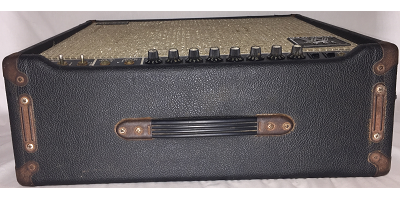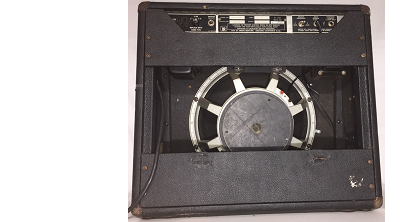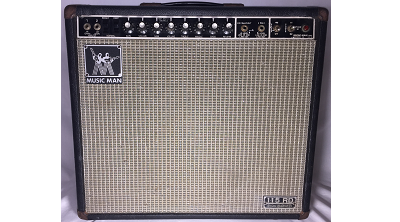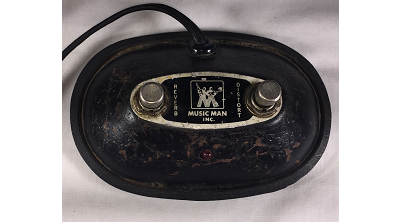Music Man 100w Guitar Amplifier with Eminence 15" speaker
$1,400.00
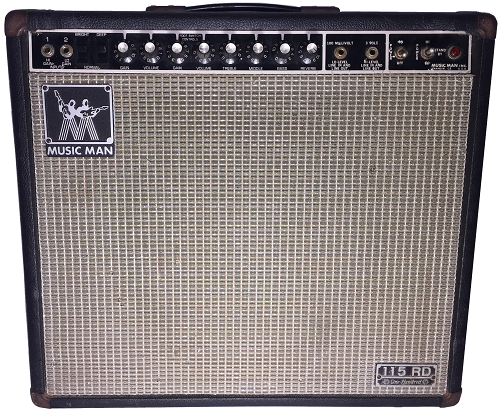
Model# 115-RD-100
100w 6L6GC Groove Tubes Guitar Combo Amplifier, turn it up and stand to close it will literally blow the hair on your legs ~ Nothin But Tone! I love the sound, best spring reverb I ever heard
💀 A Blond Melon Favorite
The history of the Music Man company began about 1971 when Tom Walker, Forrest White and Leo Fender started a company called Tri-Sonic. Walker and White had worked for Fender before. Leo Fender himself had to sign a 10 years non-compete contract when he sold his company Fender Musical Instruments to the CBS Corporation in 1965, so he remained in the background until 1975.
In 1974 the company name was changed to Music Man, and in 1975 Leo Fender was named as its president.
Music Man started their amp line in 1974. It is not absolutely clear in how far Leo Fender was involved with the design of these amps, most sources say that alone Tom Walker was responsible for the amps, while Leo Fender designed the guitars and bass guitars.
The first Music Man amp – a head called Sixty-five – had already most features of all later models. the 115-RD is a hybrid design with a tube output section and a solid-state pre-amp section. Overall look and control layout similar to Fender amps
The hybrid design – Get that Fender sound with a solid-state design
Fender amps were basically built for a clean sound. The distortion that is created when a tube amp is overdriven was something invented by creative musicians or by chance when musicians tried to get as much volume out of their amps as possible. Fender didn`t focus on the distorted sound, in the contrary, they even tried to avoid it. In the mid-seventies , the famous Fender Twin Reverb even made use of some tricks often found in HIFI amps to reduce as much distortion as possible (the so-called ultra-linear circuit).
It is surely fair to say that Music Man followed the footsteps of earlier Fender amps, so their amps were also aimed at the best possible clean sound. So it is not a big surprise that they used a solid-state design (ICs and transistors) for the pre-amp section. Solid-state requires lower voltage and less energy and thus causes less heat. For this reason it was considered as more reliable than tubes.
The whole pre-amp section is mounted on a printed circuit board, while Fender amps still used point-to-point wiring for their amps at this time.
Tube power for warmth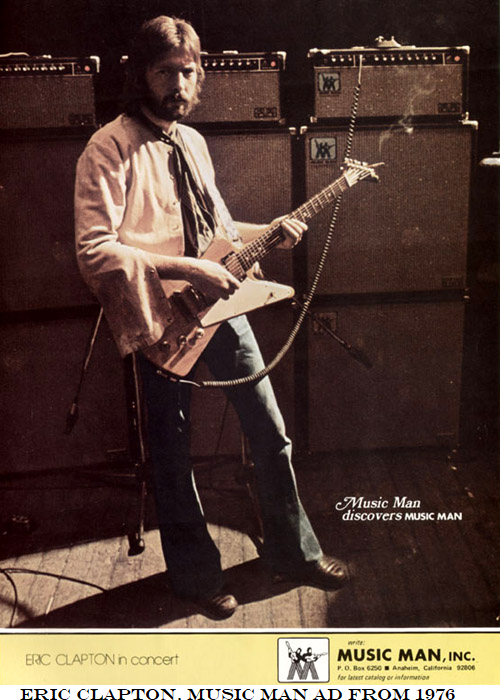
The output section of the first Music Man amps used 6CA7 power tubes. A tube output section adds a certain warmth and subtle distortion to the clean sound. This is the opposite approach to the more modern approach of using a tube pre-amp with a heavy-duty solid-state power amp, a setup more suited for that singing, high-gain distortion.
However, the circuit was rather different from Marshall. The power tubes in a Music Man amp operate at up to 700 volts at the plate. Fender or other tube amps – including Marshalls – normally have about 450 – 550 volts here.
About 1980 Music Man changed from 6CA7 to 6L6 tubes. Apparently this had not to do with tonal preference but with supply facilities at that time. Generally the amps kept their typical Music Man sound, no matter whether they had 6CA7/EL34 or 6L6.
Guitar combo amplifier Music Man 115 RD One Hundred model is a two-channel amp. The reverb effect affects the second channel only.
The reverb was based on a Acutronics reverb spring, similar to the one in Fender amps. However, the reverb sound is different – thinner and brighter – than the extremely warm Fender reverb. This is rather due to the circuit design than to the spring itself. The tremolo effect is very effective, but also sounds different than on Fender amps.
Hi Lo switch - It switches from high power to low power. It does not switch off two tubes like other designs but decreases voltages for lower output. In most cases the low setting will do, and it saves tube life. Mark seemed to have it always in the high position.
Other important players of that time who used Music Man were Eric Clapton, Johnny Winter, Albert Lee and Heart just to name a few.
💀 Note from Blond Melon:
Turn the bright switch down the deep switch up and the toggle to hi plug into the high gain input and rock out Aerosmith style
Most early Music Man amps had speaker made by Eminence, typically models with square alnico magnets. About 1980 they changed to round ceramic magnets, still produced by Eminence. However, some models with 10″ speakers always had ceramic magnets.
Features
• Guitar combo amplifier Music Man 115 RD One Hundred.
• Amp speaker was recently re-coned with modern speaker parts
• Diaphragms installed now even better sound then the original
• From your bass to your treble tones everything stays the same volume
• Everything Is in and above perfect working order
• Good visual shape, typical marks and scratches which comes form normal usage.
• Original footswitch included (hard wired)
• Groove Tubes Installed by Blond Melon
• Speaker recently re-cone by Carl at Visit South Florida Speaker!
• Mounts holes for peg castors on the bottom of the amp
SpecificationThis is a Professional Amplifier - you are only as good as your sounds tone…
Amplification: Tube analog guitar combo
Valves: 2x 6L6GC Groove Tubes
Power: 100W
Tone: 3-band EQ - Treble, Mid, Bass
Acquisitions: Bright and Deep switches
Venue Control: Hi Gain, Lo Gain switch
Line in/out: Lo-100 milivolt or 3 volt
Effects: Spring reverb
Foot Control: fixed cable with two stomp buttons, one two toggle between channels the other is on/off control of the reverb
Dynamics: 1x15" Eminence speaker.
Used – Very Good
Same Day Shipping - Ships from Blonds personal stash
Located in: New Orleans, Louisiana, United States
Handling Cost:
$20.00 will be added on items over 30lb
$50.00 will be added on items over 100lb
Free local pickup
Shipping: Calculate
make an offer
